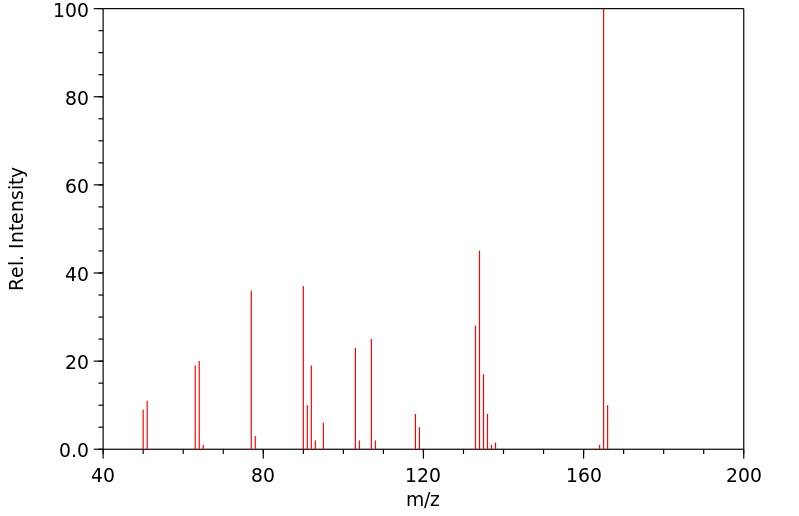4-methoxybenzaldehyde O-methyl oxime | 70286-37-2
中文名称
——
中文别名
——
英文名称
4-methoxybenzaldehyde O-methyl oxime
英文别名
4-methoxybenzaldehyde O-methyloxime;p-Methoxybenzaldoxim-O-methylether;O-Methyl-p-anisaldoxime;N-methoxy-1-(4-methoxyphenyl)methanimine
CAS
70286-37-2;87861-04-9;33499-40-0
化学式
C9H11NO2
mdl
——
分子量
165.192
InChiKey
FRLGNZPYLCIAQC-UHFFFAOYSA-N
BEILSTEIN
——
EINECS
——
-
物化性质
-
计算性质
-
ADMET
-
安全信息
-
SDS
-
制备方法与用途
-
上下游信息
-
文献信息
-
表征谱图
-
同类化合物
-
相关功能分类
-
相关结构分类
物化性质
-
熔点:76 °C
-
沸点:239.7±42.0 °C(Predicted)
-
密度:1.00±0.1 g/cm3(Predicted)
-
保留指数:1339
计算性质
-
辛醇/水分配系数(LogP):1.9
-
重原子数:12
-
可旋转键数:3
-
环数:1.0
-
sp3杂化的碳原子比例:0.22
-
拓扑面积:30.8
-
氢给体数:0
-
氢受体数:3
SDS
上下游信息
反应信息
-
作为反应物:描述:4-methoxybenzaldehyde O-methyl oxime 在 RuCl2(1,3-dimesityl-imidazolidin-2-yl)(PCy3)(=CHPh) 、 silver hexafluoroantimonate 、 di-μ-chlorobis(norbornadiene)dirhodium(I) 作用下, 以 二氯甲烷 、 1,2-二氯乙烷 为溶剂, 反应 21.0h, 生成 methyl (E)-3-((2R,4S)-3-methoxy-2-(4-methoxyphenyl)-1-tosylimidazolidin-4-yl)acrylate参考文献:名称:铑(I)催化的乙烯基氮丙啶和肟醚的[3 + 2]-环加成反应中的手性转移:手性咪唑烷的原子经济合成摘要:通过铑催化的手性乙烯基氮丙啶和肟醚的分子间[3 + 2]环加成反应,已成功开发了对映体富集的咪唑烷的高效立体选择性合成。值得注意的是,醛肟和酮肟都是合适的底物,以高收率和良好的立体选择性提供相应的手性咪唑烷。这种转化代表了一个空前的例子,该例子在乙烯基氮丙啶的环加成中利用酮亚胺衍生物作为氮杂[2C]组分。DOI:10.1021/acs.orglett.8b01378
-
作为产物:描述:对甲氧基苯甲醛肟 、 碘甲烷 在 potassium carbonate 作用下, 以 丙酮 为溶剂, 反应 24.0h, 以84%的产率得到4-methoxybenzaldehyde O-methyl oxime参考文献:名称:细菌铁载体的环状异羟肟酸类似物作为铁络合剂,是通过未保护的肟的卡斯塔尼奥利·库什曼反应制备的摘要:描述了多组分化学(卡斯塔尼奥利-库什曼反应)在一步一步制备环状异羟肟酸中的首次应用。环状异羟肟酸是细菌铁载体(铁结合化合物)的紧密类似物,并通过分光光度法测量证实与Fe 3+离子形成稳定的络合物。这些化合物是设计用于铁超负荷疾病治疗的螯合剂以及基于铁载体的载体系统的潜在成分,这些载体系统可用于跨细菌细胞壁的抗生素递送。DOI:10.1002/chem.201704389
文献信息
-
Reaction of aldehyde O-alkyl oxime with organometallic compounds作者:Shinichi Itsuno、Koji Miyazaki、Koichi ItoDOI:10.1016/s0040-4039(00)84709-7日期:1986.1Aldehyde O-alkyl oximes were converted into ketones with high yields when they were treated with alkyllithium compounds or Grignard reagents followed by hydrolysis. Amines as reductive alkylation products of aldehyde O-alkyl oximes were also obtained by BH3 reduction before hydrolysis.
-
Novel Catalytic Three-Component Reaction between a Terminal Alkyne, Sulfonyl Azide, and O-Methyl Oxime作者:Mehdi Khalaj、Majid Ghazanfarpour-Darjani、Forugh Barat-Seftejani、Azita NouriDOI:10.1055/s-0036-1588989日期:2017.7O-Methyl oximes have been employed as nucleophiles in reactions with ketenimines derived from sulfonyl azides and terminal alkynes to form N-alkylidene N′-tosylacetimidamide derivatives. The optimized conditions involved the use of CuPF6 and i-Pr2NEt in MeCN at 65 °C. Both O-methyl aldoximes and ketoximes were tolerated under the optimum conditions.
-
Tandem Oxidation Processes: The Direct Conversion of Activated Alcohols into Oximes; Synthesis of Citaldoxime作者:Richard J. Taylor、Hisashi KannoDOI:10.1055/s-2002-32949日期:——The direct conversion of primary alcohols into oximes is reported using manganese dioxide and alkoxylamines/hydroxylamine as their hydrochloride salts or supported on Amberlyst 15. This transformation has been applied to a range of benzylic, allylic and propargylic alcohols and utilised to prepare the natural product citaldoxime.
-
Rh(III)-Catalyzed C–H Amidation of Arenes with <i>N</i>-Methoxyamide as an Amidating Reagent作者:Guodong Ju、Guobao Li、Guanwen Qian、Jingyu Zhang、Yingsheng ZhaoDOI:10.1021/acs.orglett.9b02625日期:2019.9.20The Rh(III)-catalyzed amidation of C(sp2)-H bonds has been reported by employing the N-methoxyamide as a novel amino source. An excellent level of functional group tolerance can be achieved when N-methoxyamide derivatives are used as the amidating reagents. Importantly, several known bioactive compounds such as Aminalon, Pregabalin, Gabapentin, and Probenecid can be transformed to effective amidating
-
Cascade C–H Annulation of Aldoximes with Alkynes Using O<sub>2</sub> as the Sole Oxidant: One-Pot Access to Multisubstituted Protoberberine Skeletons作者:Junbin Tang、Shiqing Li、Zheng Liu、Yinsong Zhao、Zhijie She、Vilas D. Kadam、Ge Gao、Jingbo Lan、Jingsong YouDOI:10.1021/acs.orglett.6b03772日期:2017.2.3also achieved under slightly modified conditions. This protocol provides an efficient one-pot access to multisubstituted dehydroberberinium skeletons from simple starting materials, which can be easily transformed into berberinium and tetrahydroberberine skeletons by controlled hydrogenation.
表征谱图
-
氢谱1HNMR
-
质谱MS
-
碳谱13CNMR
-
红外IR
-
拉曼Raman
-
峰位数据
-
峰位匹配
-
表征信息
同类化合物
(R)-3-(叔丁基)-4-(2,6-二异丙氧基苯基)-2,3-二氢苯并[d][1,3]氧杂磷杂环戊烯
(2S,3R)-3-(叔丁基)-2-(二叔丁基膦基)-4-甲氧基-2,3-二氢苯并[d][1,3]氧杂磷杂戊环
(2S,2''S,3S,3''S)-3,3''-二叔丁基-4,4''-二甲氧基-2,2'',3,3''-四氢-2,2''-联苯并[d][1,3]氧杂磷杂戊环
(2R,2''R,3R,3''R)-3,3''-二叔丁基-4,4''-二甲氧基-2,2'',3,3''-四氢-2,2''-联苯并[d][1,3]氧杂磷杂戊环
(2-氟-3-异丙氧基苯基)三氟硼酸钾
(+)-6,6'-{[(1R,3R)-1,3-二甲基-1,3基]双(氧)}双[4,8-双(叔丁基)-2,10-二甲氧基-丙二醇
麦角甾烷-6-酮,2,3,22,23-四羟基-,(2a,3a,5a,22S,23S)-
鲁前列醇
顺式6-(对甲氧基苯基)-5-己烯酸
顺式-铂戊脒碘化物
顺式-四氢-2-苯氧基-N,N,N-三甲基-2H-吡喃-3-铵碘化物
顺式-4-甲氧基苯基1-丙烯基醚
顺式-2,4,5-三甲氧基-1-丙烯基苯
顺式-1,3-二甲基-4-苯基-2-氮杂环丁酮
非那西丁杂质7
非那西丁杂质3
非那西丁杂质22
非那西丁杂质18
非那卡因
非布司他杂质37
非布司他杂质30
非布丙醇
雷诺嗪
阿达洛尔
阿达洛尔
阿莫噁酮
阿莫兰特
阿维西利
阿索卡诺
阿米维林
阿立酮
阿曲汀中间体3
阿普洛尔
阿普斯特杂质67
阿普斯特中间体
阿普斯特中间体
阿托西汀EP杂质A
阿托莫西汀杂质24
阿托莫西汀杂质10
阿托莫西汀EP杂质C
阿尼扎芬
阿利克仑中间体3
间苯胺氢氟乙酰氯
间苯二酚二缩水甘油醚
间苯二酚二异丙醇醚
间苯二酚二(2-羟乙基)醚
间苄氧基苯乙醇
间甲苯氧基乙酸肼
间甲苯氧基乙腈
间甲苯异氰酸酯







